On Saturday, Deputy Arts Editor Isa RingswaldEgan attended arts magazine Ratrock’s Fall Featured Artist Showcase, where artists highlighted in Fall 2023 showcased their craft.
As the days become a gradient of long nights and cloudy skies, and creativity seems like it’s being curtailed at every occasion, finding pockets of creatives celebrating art can revitalize the soul, and Ratrock’s showcases are the perfect environment for such renaissances. Arts magazine Ratrock, which provides a platform for artists on campus to showcase their work, hosts a featured artist showcase for each edition, where the painters, illustrators, filmmakers, writers, composers, photographers, and sculpturists featured in the edition perform and put their work on display.
Started in 2016, the magazine publishes twice per academic year, once in the fall and once in the spring. Featured artists truly run the gamut of mediums from visual or sculptural to auditory or textual. This fall, artists of various mediums congregated at Q House for a night of celebrating expression.
Red tissue paper covered the lights, casting the house and the rest of the charmingly eclectic decorations in a cozy, artistic light. String lights snaked across the walls, illuminating the artwork and a table supporting a vase of flowers, a guest book, and snacks. Though the artists and their works were certainly taken seriously, the whole affair was altogether inviting, and accessible.
The first artist’s work displayed when I walked in was the short film, and the photography, of Norman Godinez (CC ‘24). He mostly focuses his work on portraiture, polaroids, and short films like the commercial which was projected onto the adjacent wall. The way he plays with light and angles in his portraiture highlights the subject with an almost divine feel. The layout of the photos on the wall also created a sense of order that was visually satisfying. It was interesting to note in Godinez’s case, but also with many of the other artists there, that there seemed to be a sameness between the art and the artist, many of them sort of matched the art they made. Godinez’s photography had a sense of elegance and clean lines that were paralleled in his outfit and presence.
Catty-corner to Godinez’s display, cellist and composer Dan Weitz (CC ‘24) was performing on his cello. He played music on and off throughout the night: contemporary, jazzy compositions that included a keyboard, guitar and occasional vocals. There was a sense of seriousness, but also of play. Weitz himself was clearly engrossed in his work, and moved expressively with the music. The red light that filled the room emphasized the jazzy tone of the pieces.
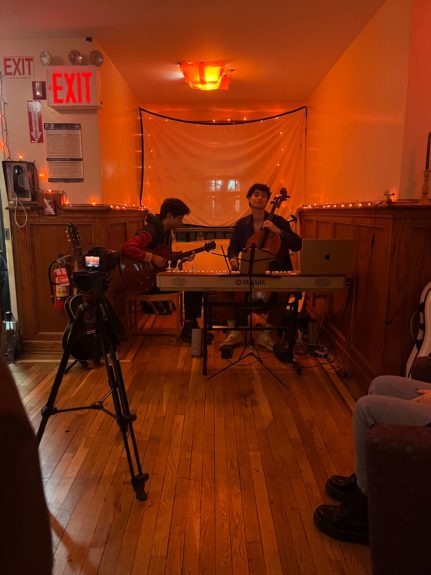
Moving further into Q House, I passed the table with the guest book, and then encountered some of visual artist Ava Frisina’s (CC ‘24) work. Full of color and whimsy, Frisina’s various mediums juxtapose the structure of design and architecture with the intimacy of scrapbooking, and the creativity of sculpture to create a vibrant and provocative body of work. Her illustrations feel relaxed and free-flowing, while some of her more structural work feels strong and grounded. Some of her scrapbooks were out on a table for attendees to flip through. I found this somewhat interactive element charming, and as I flipped through her work, I realized how personal displaying something of this nature is. Diary entries, notes from friends, and illustrations of strong emotion filled the book.
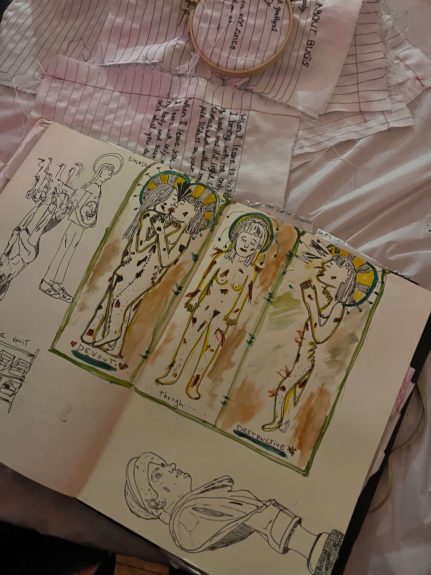
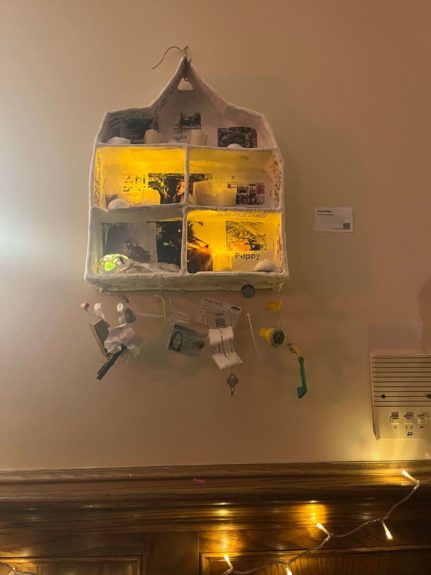
On the table next to Frisina’s scrapbooks was a sculpture from another visual and performance artist, Hart Hallos (CC ‘24). Hallos’s work is similarly playful to Frisina’s, with bright colors, many mediums and certain elements with a child-like feel. Hallos, however, incorporates more of a performative element in their work, though the performance element was not included at this event. Their use of texture and form in their illustrations, sculptures and garments creates a myriad of emotions in the viewer.
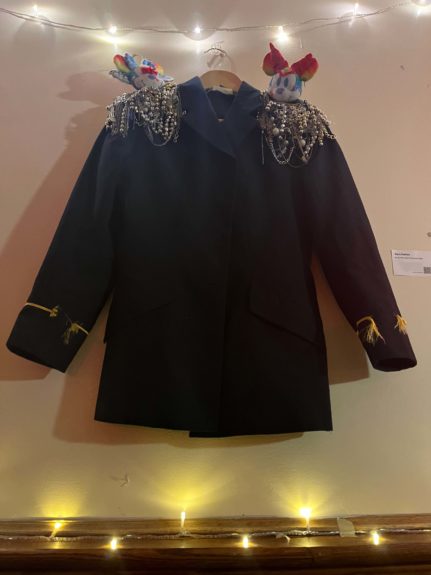
Jaime Iacovitti’s (CC ‘25) data-bended photography evoked similarly indescribable emotions. Photos of nature, the city, and other elements of everyday life paired with intentionally and artistically corrupted data are what Iacovitti focuses on, making his photos bright, overstimulating, and difficult to decipher, but in a somehow compelling way.
The only writer featured at the event, Sofía Trujillo (BC ‘25), had an interesting visual component to her display as well. Pages of her writing were pasted on the wall, overlapping in back of a pile of packets available to pick up and read. The contents were comedic, poignant, and well-written. The visual component really heightened the interest in the display, and got attendees interested in picking up some of her work
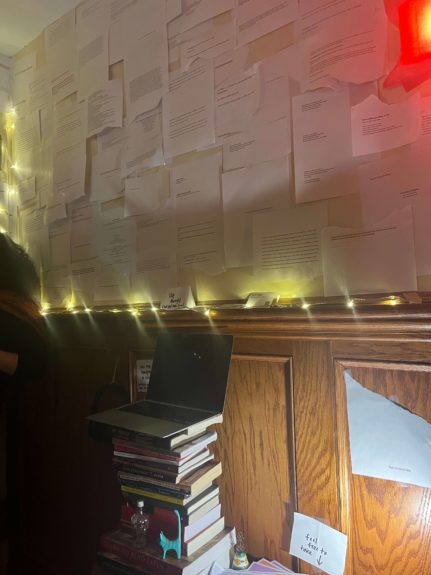
The art of Linnea Hopkins-Eskdahl (CC ‘24) sat on the same wall. Hopkins-Eskdahl paints, collages, and photographs. The pieces on display portrayed aspects of everyday life, scenes that felt quintessential to the vibe of someone I had never met. Neon pink underpaintings and a portrait of over a dozen various Captain America memorabilia items reinforced the uniqueness of her art.
It was such a joy to see all of these artists being able to display their work and, likewise, students out appreciating art. Both making and viewing are utterly vulnerable acts. Sometimes it can seem easier not to take creative risks, or not to look at the art with an open-mind and go straight for a critique, but the artists and attendees of the event showed their vulnerability in their willingness to make and appreciate art that makes people’s lives more beautiful.
All Images via Author


 0 Comments
0 Comments